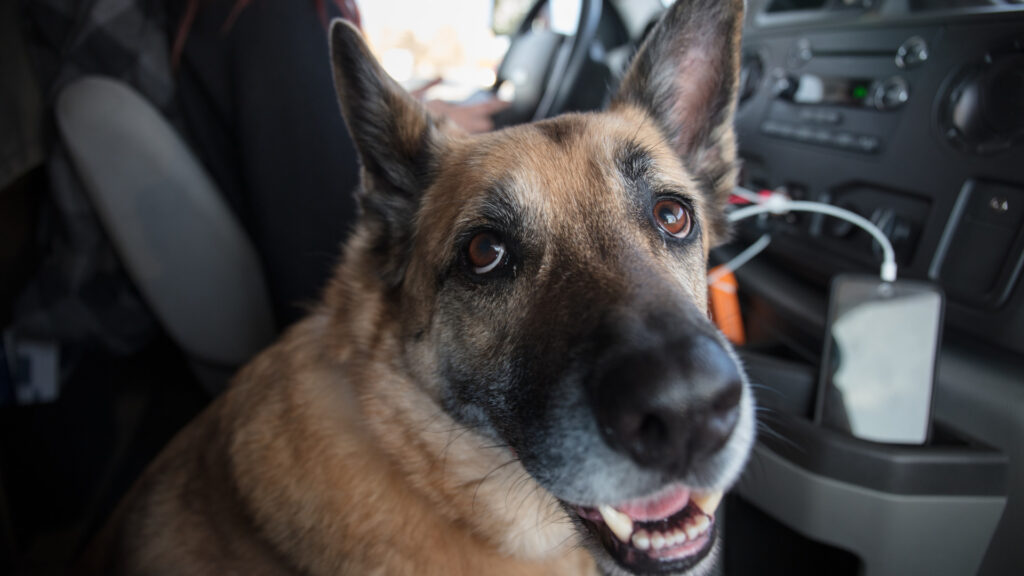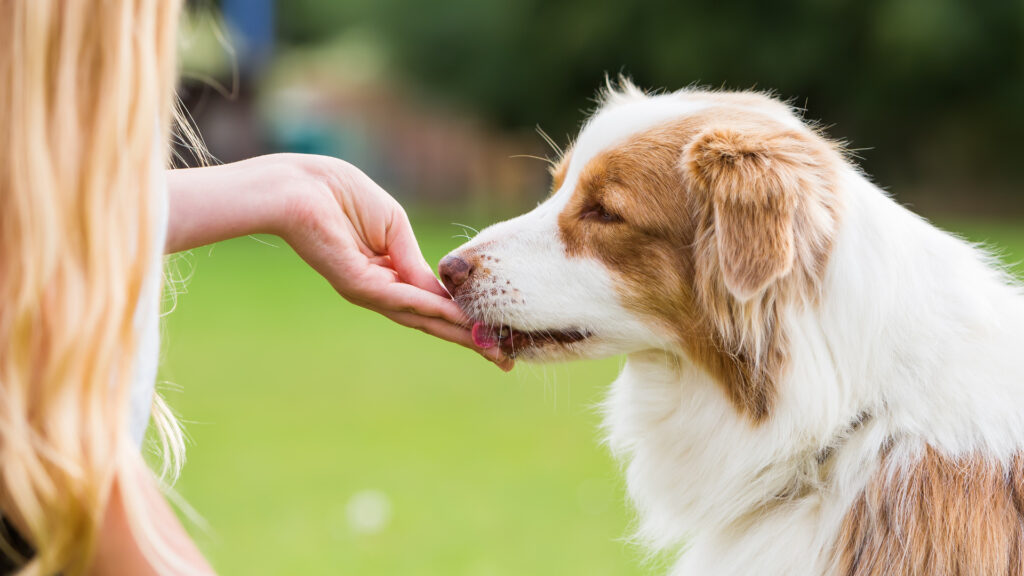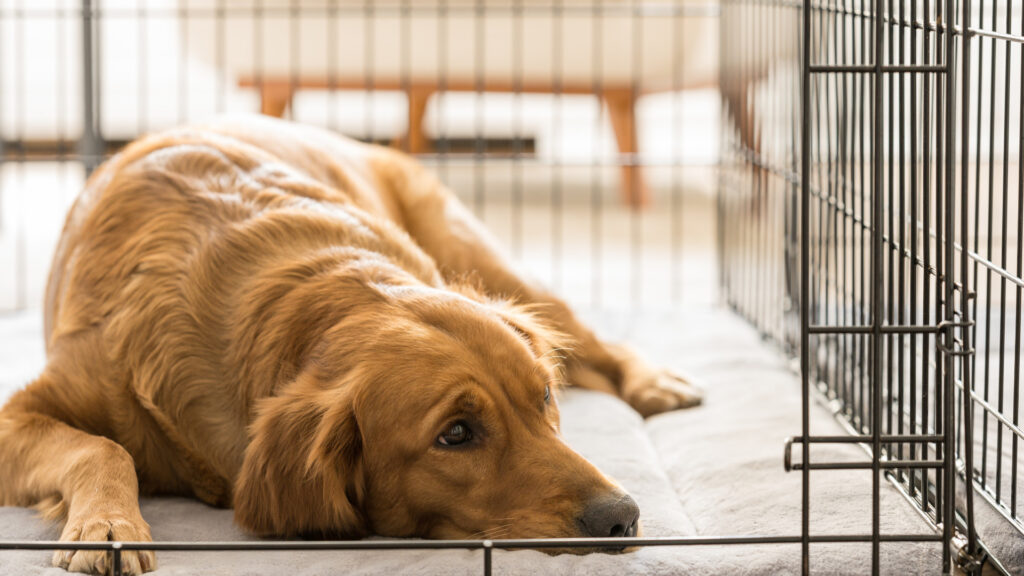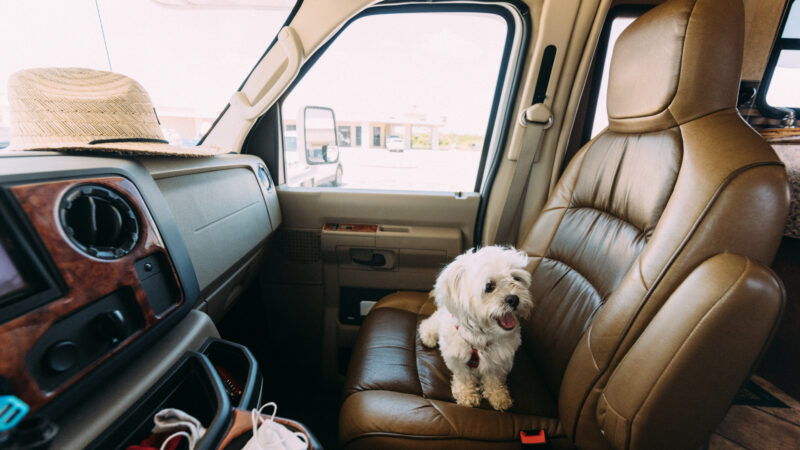Table of Contents Show
Travel days can induce anxiety for everyone, including your pets. With so many tasks to complete and things to do, getting on the road can feel chaotic.
These situations take dogs out of their normal routines and familiar surroundings. If you want your dog to be as comfortable as possible, you must take steps to soothe their anxiety.
We hit the jackpot with Carmen for many reasons, but she’s been a fantastic traveler throughout our journeys. However, we’ve had a rough travel day or two and found some strategies and techniques to help her relax on the road.
Today, we’re sharing these tips with you, so you and your pet can enjoy less-stressful travel days.
So cuddle up with your furry best friend, and let’s get started!
Do Dogs Get Anxious When Traveling?
Dogs, like humans, are creatures of habit. They’ll quickly notice when something is off or different from their routine.
When this occurs, it’s not uncommon for them to become anxious. Traveling can be overwhelming for dogs as they typically experience unfamiliar sounds, smells, and experiences.
Additionally, some dogs suffer from serious cases of separation anxiety or loneliness. Issues can start to arise long before your travels begin. Something as simple as getting a suitcase out of storage or packing up your camper could indicate to your pup that you’re preparing to travel.
It’s important to recognize this and to be as patient as possible with your dog. Provide comfort and assurance to them to help ease their worries. You need to be aware of your pet in these circumstances and look for signs of them experiencing anxiety.
What Are Signs of Anxiety in Dogs?
Various activities and situations can induce anxiety in dogs. For some, it’s separation, loud noises, or new environments. However, there’s no telling what could spark increased discomfort in your pet. You must recognize a few common signs of anxiety in dogs to help soothe and comfort them.
The most common signs of anxiety in dogs are panting and trembling. Dogs may begin to pant excessively, even during cooler temperatures. Additionally, they may start to shake uncontrollably or tremble.
They may appear restless and have trouble settling down or sleeping. It’s common for them to pace back and forth or circle relentlessly when they feel uncomfortable.
Some dogs even exhibit uncharacteristic behaviors like excessively barking, whining, or becoming destructive. They’re typically trying to communicate their discomfort to their owner in hopes of them easing their worries. If barking and whining don’t work, they could start to chew, dig holes, or destroy toys or other items.

Can a Dog Grow Out of Anxiety?
Anxiety is rather common in dogs at one point or another. Some dogs may experience anxiety due to environmental conditions, life events, or a stage of development.
It’s common for puppies to experience separation anxiety and outgrow the feelings as they grow older and become less dependent on others.
Unfortunately, anxiety can be a life-long battle for some dogs. Owners must recognize this and get to the root of the cause. It may require behavior modification, training, medication, or a combination of approaches.
Dealing with a dog with severe anxiety can feel stressful and overwhelming. As a result, owners must work with veterinarians or dog behaviorists to develop a proper treatment plan.
If all goes as planned, there’s a good chance you and your dog can enjoy anxiety-free travels and make many unforgettable memories together.
Pro Tip: If you haven’t camped with your furry friends before, check out these Insider Tips for Successfully Camping with Dogs
What Scent Calms Dogs?
Some owners have had success using scents to calm their dogs when traveling. Lavender is often cited as one of the most soothing scents for dogs and their owners. These smells typically have natural properties to promote relaxation and reduce anxious feelings.
Research supports the belief that lavender helps lower blood pressure, heart rate, and skin temperature. If you notice your pet showing signs of anxiety, it might help to introduce some lavender scents to try to soothe them.
Additionally, other calming scents include chamomile, valerian, and bergamot. You can use aromatherapy or natural products like candles and sprays. However, not all dogs will benefit from calming scents.
Check with your veterinarian and see how scents could fit into your overall anxiety treatment plan. Additionally, certain smells and essential oils can be harmful to dogs, so research them before use.
Tips to Sooth Your Anxious Dog on Travel Days
You can do several things to help soothe your anxious dog on travel days. If you’re frequently traveling, these can help tips can make travel days easier and less stressful for you and your dog.
Prepare Your Dog in Advance
If at all possible, prepare your dog in advance. If you know you’ll take your pet on road trips, introduce them to the vehicle as young as possible.
This can help them adjust to the sights, sounds, and movements of spending extended time in a car. Start with shorter trips and work up to more extended ones as they adjust.
During these road trips, pack towels and extra cleaning supplies. You may discover that your dog is prone to motion sickness or has a weak bladder. Some pets may drool more when feeling motion sick. You’ll want to quickly and thoroughly clean up any messes they create.
Pack Familiar Items
Just like many of us had security or comfort blankets when we were younger, some dogs are no different. They may have a favorite blanket, bedding, toy, or other items that can help reduce their anxiety.
Access to familiar items can help them feel more relaxed and less anxious. These items contain scents that make them feel at home. It can help them feel safer in different environments. If their stomachs are up for it, reward them with a treat throughout the trip.

Use a Calming Aid
If you’re comfortable with it, there are a variety of safe and effective calming aids on the market. You can find supplements, CBD oil, and calming pheromone sprays.
Again, check with your veterinarian before introducing new or unfamiliar products to your pet. Additionally, they may have prescription medications that help them relax.
If you’ve ever experienced the benefits of a weighted blanket, a Thundershirt is the dog equivalent. These jackets apply gentle pressure to your dog’s body to create a calming effect that can reduce anxiety.
Weighted blankets can work great for humans, so why shouldn’t we expect the same for pets?
- ThunderShirt is the #1 vet recommended calming wrap & already used by millions of dogs to help calm anxious behaviors!
- Our patented*, easy-to-use calming wrap for dogs is a drug-free option which applies gentle calming pressure around your...
Take Breaks
While you can last for several hours traveling the open roads, your pet may not.
Depending on the size of your vehicle, they may require more frequent breaks. Build in stops into your travel plans to allow your pet to get out of the vehicle, stretch their legs, and burn off some energy.
Limit the length of your travel days until you discover how your dog will handle them. Be careful to give them only a little food or water during breaks, or you could end up with a mess in your car when you get back on the road.
Keep in Mind: Sometimes it can be a challenge to find a rest stop! However, this is easiest way to Find one on your route
Keep them Occupied
Just like parents with small kids, the trip will go smoother for you and your dog if you can keep them occupied. Give them toys and treats, and play calming music to soothe them. You can find plenty of playlists created for dogs.
These can help keep you and your pet calm until you reach your destination. You may also consider giving them a chew toy to keep them focused on the treat, not the stress of traveling.
Consider Crate Training
Sometimes it will be safest for your pet to remain in a crate while traveling. If so, you’ll want to crate-train them in advance. Some dogs find their crate their safe place and are more comfortable in them than out in the open.
When crate training your dog, always use positive reinforcement. Introduce them to it gradually and make sure they feel as comfortable as possible. Use soft and comfortable bedding to give them a cozy spot to relax.
Depending on the dog, they may not need to spend the entire trip in the crate. However, placing them in their crate might be a good idea if they start exhibiting signs of anxiety.

Maintain a Comfortable Temperature in the Vehicle
If your dog suffers from anxiety, uncomfortable temperatures can drastically increase discomfort.
Use air conditioning or heat to regulate the temperature as much as possible. If your pet is on the floor, be aware of the vents and ensure they’re not overheating or getting too uncomfortable.
Additionally, be mindful of the sun coming in from the outside, and use window shades to help block the sun from getting to your pet.
Always monitor your dog and ensure they appropriately handle the temperature and vehicle conditions. No matter how quick a trip will be, never leave them in a parked car, no matter the season.
Ensure a Safe and Comfortable Travel Day for Your Anxious Dog
If you want you and your pet to have a safe and comfortable travel day, you must learn to control their anxiety.
Helping ease their stress can ensure you can enjoy the entire experience. If not, it could be a long travel day, and you may have to leave them behind when traveling.
Luckily, you have plenty of great options to try to create a plan to help them stay calm.
Does your dog have travel anxiety?
Last update on 2025-01-19 / Affiliate links / Images from Amazon Product Advertising API







